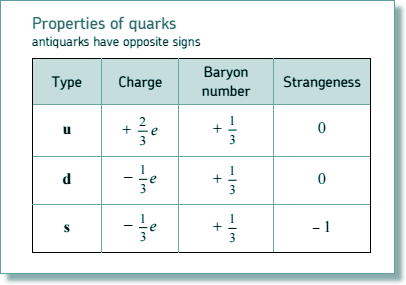Particle Physics Questions
Q11.
(a) Complete the table comparing some of the properties of the positive pion, π+, and the proton
Name |
π+ |
Proton |
Relative charge |
+1 |
+1  |
Baryon number |
0  |
+1  |
Quark composition |
u ̅d̅  |
uud  |

(b) When a positive pion interacts with a proton, a kaon can be produced, along with another strange particle, as shown in this equation

What type of interaction is shown in this equation?
Strong nuclear interaction 
(1mark)
(c) Deduce the relative charge, baryon number and strangeness of particle X.

conservation of charge:
+1 +1 → +1 + ?
charge of particle X must be +1 
conservation of baryon number:
0 + 1 → 0 + ?
baryon number of particle X must be +1 
conservation of strangeness:
0 + 0 → 1 + ?
strangeness of particle X must be -1 
(3marks)
(d) Particle X can decay to produce a neutron and positive pion as shown in this equation

What type of interaction is shown in this equation?
Weak nuclear interaction 
(1mark)
(e) Explain your answer.
The strangeness of X is -1, the strangeness of the pion and neutron are both zero so strangeness is not conserved.  This can only occur in weak interactions.
This can only occur in weak interactions. 
(2 marks)
(f) The neutron and positive pion will then decay. The positive pion can decay into a positron and an electron neutrino.
Write down the equation for the decay of the neutron.
n → p  + e- + ̅ν̅e
+ e- + ̅ν̅e 
(2 marks)
(g) Explain why no further decays occur.
The proton is a stable particle (in fact it is the only stable baryon!)  and the electron and antineutrino are stable fundamental particles
and the electron and antineutrino are stable fundamental particles . None of them decay.
. None of them decay.
(2 marks)
(Total 16 marks)


